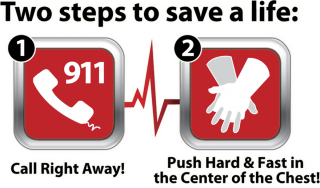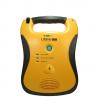CPR, AED, & First Aid

CPR
North Yarmouth Fire Rescue and the Town of North Yarmouth has been named a "Heartsafe Community" in Maine. It is with this is mind that we want to make sure as many citizens within our community know CPR. We also understand that many citizens may not need a certification or they may not want to do mouth-to-mouth ventilations. For those who fall into this category we would like you to learn "Hands Only CPR"
"Hands Only CPR" is a simple course that teaches you the basic information you need to know to perform CPR.
Please click the link below to be brought to a short video that will walk you through performing CPR. Please note - This instruction is for performing CPR on a person 8 years of age or older. Also, this does not constitute a certification. This training is for community members who want the ability to save a life without using mouth-to-mouth ventilations or obtaining a certification card.
AED

What is an AED?
An automated external defibrillator (AED) is a lightweight, portable device that delivers an electric shock through the chest to the heart. The shock can stop an irregular heart rhythm and allow a normal rhythm to resume following sudden cardiac arrest. Sudden cardiac arrest is an abrupt loss of heart function. If it’s not treated within minutes, it quickly leads to death.
Most sudden cardiac arrests result from ventricular fibrillation. This is a rapid and unsynchronized heart rhythm starting in the heart’s lower pumping chambers (the ventricles). The heart must be "defibrillated" quickly, because a victim’s chance of surviving drops by seven to 10 percent for every minute a normal heartbeat isn’t restored.
Why are AEDs important?
AEDs make it possible for more people to respond to a medical emergency where defibrillation is required. Because AEDs are portable, they can be used by nonmedical people. They can be made part of emergency response programs that also include rapid use of 9-1-1 and prompt delivery of cardio pulmonary resuscitation (CPR). All three of these activities are vital to improving survival from cardiac arrest.
How does an AED work?
A built-in computer checks a victim’s heart rhythm through adhesive electrodes. The computer calculates whether defibrillation is needed. If it is, a recorded voice tells the rescuer to press the shock button on the AED. This shock momentarily stuns the heart and stops all activity. It gives the heart the chance to resume beating effectively. Instructions guide the user through the process. AEDs advise a shock only for ventricular fibrillation or another life-threatening condition called pulseless ventricular tachycardia.
Who can use an AED?
Non-medical personnel such as police, fire service personnel, flight attendants, security guards and other lay rescuers who have been properly trained can use AEDs.
Are AEDs safe to use?
AEDs are safe to use by anyone who’s been trained to operate them. Studies have shown that 90 percent of the time AEDs are able to detect a rhythm that should be defibrillated. And 95 percent of the time they are able to recommend NOT shocking when the computer shows defibrillation is not indicated.
Where should AEDs be placed?
All first-response vehicles, including ambulances, law-enforcement vehicles and many fire engines should have an AED.
AEDs also should be placed in public areas such as sports arenas, gated communities, airports, office complexes, and doctors’ offices. They should also be in any other public or private place where large numbers of people gather or where people at high risk for heart attacks live.
First Aid:
First Aid is the provision of immediate medical assistance to an ill or injured person until definitive medical treatment can be accessed, or until the illness or injury is fully dealt with.
- It generally consists of a series of simple, potentially life-saving steps that an individual can be trained to perform with minimal equipment:
- The principle of first aid is immediate action.
- Any action taken needs to be careful and deliberate and the first-aider should remain calm at all times.
- The first priority is to yourself and other bystanders. Assess for danger and think before you act. There may be gas - risk of explosion or asphyxiation; electricity - the pool of water around the faulty washing machine may be live; fire - opening a hot door may be the last thing you should do; assault - the assailant with a knife or a gun may be behind the door awaiting their next victim or a hostage; blood - avoid unnecessary contact with bodily fluids by wearing gloves and a face shield if available.
It is important to assess the situation quickly, to appreciate the limitations of your own actions and to seek expert assistance - eg, by calling 911 for ambulance, police or fire service help as soon as possible.
Nosebleeds
Nosebleeds are extremely common. They are usually benign, self-limiting and spontaneous. Trauma to the nose, especially nose picking, is the most common underlying cause.
If the person is haemodynamically unstable, call 911 and resuscitate/apply First Aid measures whilst waiting for the ambulance to arrive. Wear disposable gloves and a face shield if available.
If the person is haemodynamically stable
Sit them down, ensure they are leaning slightly forward and tell them to pinch the soft, fleshy part of their nose firmly for 10-15 minutes.
Their mouth should be open so that they can breathe through their mouth and can spit out any blood from their mouth into a sink, bowl or container in front of them.
Monitor their pulse and their blood pressure.
Traditionally advice has included keeping the patient cool, and in hospital ice packs are usually applied to the patient's neck. However, the evidence shows that it does not reduce blood flow to the nose
After 10-15 minutes, they can gently release the pressure to see if the bleeding is controlled. If it is not controlled, tell them to pinch again.
If the bleeding does not stop after 10-15 minutes of pressure, and cautery or packing are not possible in primary care due to lack of facilities or expertise, send the person to Accident and Emergency.
Burns and scalds
Ensure your own safety. Wear protective clothing as needed. Approach with care. Call for help as needed.
Stop the burning process:
Remove the heat source.
Help the person to drop and roll if clothing is on fire
Turn the power off if electricity is involved
Assess Airway, Breathing and Circulation and look for other injuries.
Remove clothing and any jewellery (unless clothing is stuck to the skin).
Cool the area that has been burnt, using running, cool/tepid water for 10-30 minutes.
Watch that you do not over-cool the person if a large area has been burnt. Keep the person warm.
For chemical burns, wear protective gloves, remove any contaminated clothing, brush any powder chemical off the skin and irrigate the area for 60 minutes
Once cooling is completed, cover the burn to protect the skin, help relieve pain from exposed nerve endings and keep the area clean. Cling film makes a good burn cover. Cover the burn lengthways with the cling film. Do not wrap tightly around a limb[6]. Clean plastic bags can be considered to cover hands and feet.
Provide pain relief.
Elevate the affected area if edema and swelling are present.

